
A more powerful 14" (35.6 cm) gun used on the New Mexico and Tennessee Class Battleships and planned for the 1916 design of the Lexington battlecruisers. The battleships had the first USN triple mounts with individual sleeves for the guns (properly called "three-gun turrets").
During the 1920s the USN had problems with dispersion with these guns at extreme ranges, with 12-gun pattern sizes ranging from 1,200 to 3,200 yards (1,100 to 2,930 m). The solutions (some possibly apocryphal) involved correcting range tables for errors, introduction of delay coils (to reduce interference in flight) and the front of the chambers were machined to improve shot seating to ensure that the shells sat properly when rammed. These changes seemed to reduce the problem, but it was not until the guns were rebuilt to reduce chamber size that the problems were really resolved.
During the ship rebuilds carried out during the 1930s, most guns were updated and redesignated as Mark 11, although USS Tennessee (BB-43) still carried the Mark 4 until 1942.
A few of these guns were used as Railroad Guns during World War I, with five units being sent to Europe before the fighting ended.
In the early 1920s, the US Army used the naval 14"/50 (35.6 cm) gun tube to arm the Model 1920 Railroad gun. This gun could be traversed through seven degrees, giving it the ability to engage moving targets. The track trucks could be removed and the carriage placed on a circular concrete foundation block which allowed a full 360 degree traverse. Two of these guns were used in the Panama Canal defenses and were capable of being moved from one ocean to the other in less than a day.
During gunnery practice on 12 June 1924 off San Pedro, USS Mississippi (BB-41) had 48 of her men asphyxiated by an explosion in her No. II main battery turret, apparently by a bore premature.
Mark 4 consisted of three hoops, two locking rings, A tube, liner and a screw box liner with a separate screwed on flange. The Mark 6 was almost identical but had a single step taper liner and uniform twist rifling. Both had Welin breech blocks that opened downwards and used Smith-Asbury mechanisms.
| Designation | 14"/50 (35.6 cm) Mark 4 and Mark 6 |
|---|---|
| Ship Class Used On | New Mexico (BB-40) and Tennessee (BB-43) classes
Lexington (CC-1) class (1916 design) 1 |
| Date Of Design | 1916 |
| Date In Service | 1918 |
| Gun Weight | about 179,614 lbs. (81,473 kg) (including breech) |
| Gun Length oa | 714.0 in (18.136 m) |
| Bore Length | 700 in (17.780 m) |
| Rifling Length | 607.4 in (15.427 m) |
| Grooves | 84 |
| Lands | N/A |
| Twist | Mark 4/0: Increasing RH 1 in 50 to 1 in 32 at the muzzle
Mark 4/3: Uniform RH 1 in 25 Mark 6: Uniform RH 1 in 25 |
| Chamber Volume | 19,555 in3 (320.5 dm3) |
| Rate Of Fire | about 1.75 rounds per minute 2 |
- ^The 1916 design of the Lexington class battlecruisers showed them with ten (2x2 and 2x3) 14"/50 (35.6 cm) guns. In the later 1920 design, these had been replaced with 16"/50 (40.6 cm) guns.
- ^In 1924 the typical firing cycle was 31 seconds for a 15 degree elevation. The firing cycle consisted of lowering the gun to the loading position in 5 seconds, loading in 12 seconds, elevating the gun back up in 5 seconds and then waiting 9 seconds for the director to align and fire the guns. Once the correct range and bearing was achieved, waiting time could be reduced by not spotting shell splashes.
| Type | Bag |
|---|---|
| Projectile Types and Weights | Early AP - 1,400 lbs. (635.0 kg)
AP Mark 8 Mods 3, 7, 8 and 11 1a - 1,402 lbs. (635.9 kg) Common - 1,400 lbs. (635.0 kg) Bombardment Mark 9 2a - 1,410 lbs. (639.6 kg) |
| Bursting Charge | Early AP - 31.5 lbs. (14.3 kg) Explosive D
AP Mark 8 - 34.3 lbs. (15.6 kg) Explosive D Common - about 84.0 lbs. (38.1 kg) Explosive D Bombardment Mark 9 - 105.0 lbs. (47.6 kg) Explosive D |
| Projectile Length | AP Mark 8 - 49.44 in (125.6 cm)
Common - about 46.5 in (118.1 cm) Bombardment Mark 9 - 56.00 in (142.2 cm) |
| Propellant Charge 3a | 470 lbs. (213.2 kg) SPD |
| Muzzle Velocity | 2,800 fps (853 mps) |
| Working Pressure | 18.0 tons/in2 (2,835 kg/cm2) |
| Approximate Barrel Life | 250 rounds |
| Ammunition stowage per gun | 100 rounds |
- ^The AP Mark 8 had a thin cap and a very small windshield. Common was obsolete by 1915 and no longer in production.
- ^Bombardment rounds were issued only to railroad artillery prior to 1942. These projectiles had thick walls and used only a base fuze.
- ^Propellant was in four bags.
- Bourrelet diameter was 13.977 inches (35.5 cm).
- For information on projectiles in use during the late 1930s - 1940s, see the 14"/50 (40.6 cm) Mark 11 data page.
| Elevation | Range | Angle of Fall | Time of Flight | Striking Velocity | Maximum Ordinate |
|---|---|---|---|---|---|
| 1.53 degrees | 4,000 yards (3,658 m) | 1.67 degrees | 4.56 seconds | 2,481 fps (756 mps) | 84 ft (27 m) |
| 3.34 degrees | 8,000 yards (7,315 m) | 3.93 degrees | 9.72 seconds | 2,190 fps (668 mps) | 379 ft (116 m) |
| 4.37 degrees | 10,000 yards (9,144 m) | 5.37 degrees | 12.57 seconds | 2,058 fps (627 mps) | 633 ft (193 m) |
| 5.50 degrees | 12,000 yards (10,973 m) | 7.03 degrees | 15.60 seconds | 1,935 fps (590 mps) | 975 ft (297 m) |
| 8.09 degrees | 16,000 yards (14,630 m) | 11.17 degrees | 22.29 seconds | 1,721 fps (525 mps) | 1,997 ft (609 m) |
| 11.19 degrees | 20,000 yards (18,288 m) | 16.60 degrees | 29.93 seconds | 1,546 fps (471 mps) | 3,599 ft (1,097 m) |
| 14.97 degrees | 24,000 yards (21,946 m) | 23.43 degrees | 38.70 seconds | 1,418 fps (432 mps) | 6,025 ft (1,836 m) |
| 19.50 degrees | 28,000 yards (25,603 m) | 31.00 degrees | 48.50 seconds | 1,354 fps (413 mps) | 9,436 ft (2,876 m) | 22.02 degrees | 30,000 yards (27,432 m) | 34.67 degrees | 53.76 seconds | 1,347 fps (411 mps) | 11,606 ft (5,162 m) | 24.70 degrees | 32,000 yards (29,261 m) | 38.33 degrees | 59.26 seconds | 1,350 fps (411 mps) | 14,106 ft (4,300 m) | 27.52 degrees | 34,000 yards (31,090 m) | 41.67 degrees | 65.02 seconds | 1,364 fps (416 mps) | 16,936 ft (3,538 m) | 30.47 degrees | 36,000 yards (32,918 m) | 45.00 degrees | 71.06 seconds | 1,391 fps (424 mps) | 20,229 ft (6,166 m) |
- ^Values for AP Mark 8 from BuOrd OP 1188 page 48.
- ^As built, the New Mexico class had a maximum elevation of 15 degrees. At that elevation, the range would be about 24,200 yards (22,128 m).
- ^As built, the Tennessee class had a maximum elevation of 30 degrees. At that elevation, the range would be about 35,600 yards (32,553 m).
| Range | Side Armor | Deck Armor |
|---|---|---|
| 6,000 yards (5,490 m) | 17.2" (437 mm) | --- |
| 9,000 yards (8,230 m) | 14.4" (366 mm) | --- |
| 12,000 yards (12,980 m) | 11.9" (302 mm) | --- |
| 16,000 yards (14,630 m) | 8.9" (226 mm) | --- |
| 20,000 yards (18,290 m) | 6.7" (170 mm) | --- |
This data is from "Elements of US Naval Guns" of 1918 and General Board file 430 (1916). It is corrected for angle of fall.
| Designation | Two-gun Turrets
Lexington (2) Three-gun Turrets
|
|---|---|
| Weight | N/A |
| Elevation | Lexington: N/A
New Mexico: -5 / +15 degrees Tennessee: -5 / +30 degrees |
| Rate of Elevation | about 4 degrees per second |
| Train | about -150 / +150 degrees |
| Rate of Train | about 2 degrees per second |
| Gun Recoil | N/A |
| Loading Angle | Lexington: N/A
New Mexico: 0 degrees Tennessee: +1 degree |
- These three-gun turrets were much improved over the previous triple designs, as their guns were individually sleeved and wider spaced. The guns could be joined together so that they could elevate as a unit. The breech block for the right and center guns swung downward at a 16 degree angle from the vertical to the right while left gun breech block swung downward at a 16 degree angle from the vertical to the left. This arrangement provided more space between the breech block and the spanner tray for handling ammunition.
- The distance between gun axes was 71 in (180 cm).
- Turrets were electrically powered with hydraulic gear.
- The turrets on the New Mexico class had a 50 hp training motor and a 50 hp elevation motor for each gun. Guns could be coupled together so as to elevate as a single unit. Ramming was powered by two 90 hp motors, the upper charge hoists were powered by two 7.5 hp motors and the two lower charge hoists by two 10 hp motors. There were originally two shell hoists supplying all three guns with the shell for the center gun being passed behind a wing gun and through the bulkhead separating the gun compartments. After rebuilds in the 1930s, each gun was given its own shell hoist. Two propellant hoists ran from the magazines to the handling room from where three propellant hoists ran up to the gunhouse.
- The turrets on the Tennessee class had a 50 hp training motor and a 50 hp elevation motor for each gun. Ramming and the upper charge hoists were powered from two 90 hp motors. The lower charge hoists were powered from two 7.5 hp motors and the shell hoists from two 35 hp motors. There were two shell hoists to supply all three guns, the center gun could be supplied by either shell hoist. Unlike the New Mexico class, these ships were not later modified to have three shell hoists. The rotating structure of the turret held a powder room above a shell room, with two propellant hoists running up to the handling room. From there, three propellant hoists ran up to the gunhouse. There were 68 shells stored on their bases in this shell room, with another 33 in the turret proper. An additional 174 in the space just inside the ring bulkhead and between the stiffeners, on the same level as the shell room. The powder room above was completely shut off from the shell room and shells traveled through the powder room in an armored tube. A few shells were stored below the handling room level, 50 on the deck below, 20 within the base of the mounting and 7 in a passageway. These 77 shells were difficult to get up and into the hoists and should be seen as being more of a reserve stock that would be moved only between engagements.
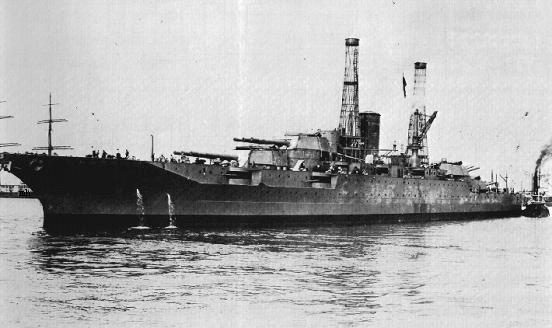
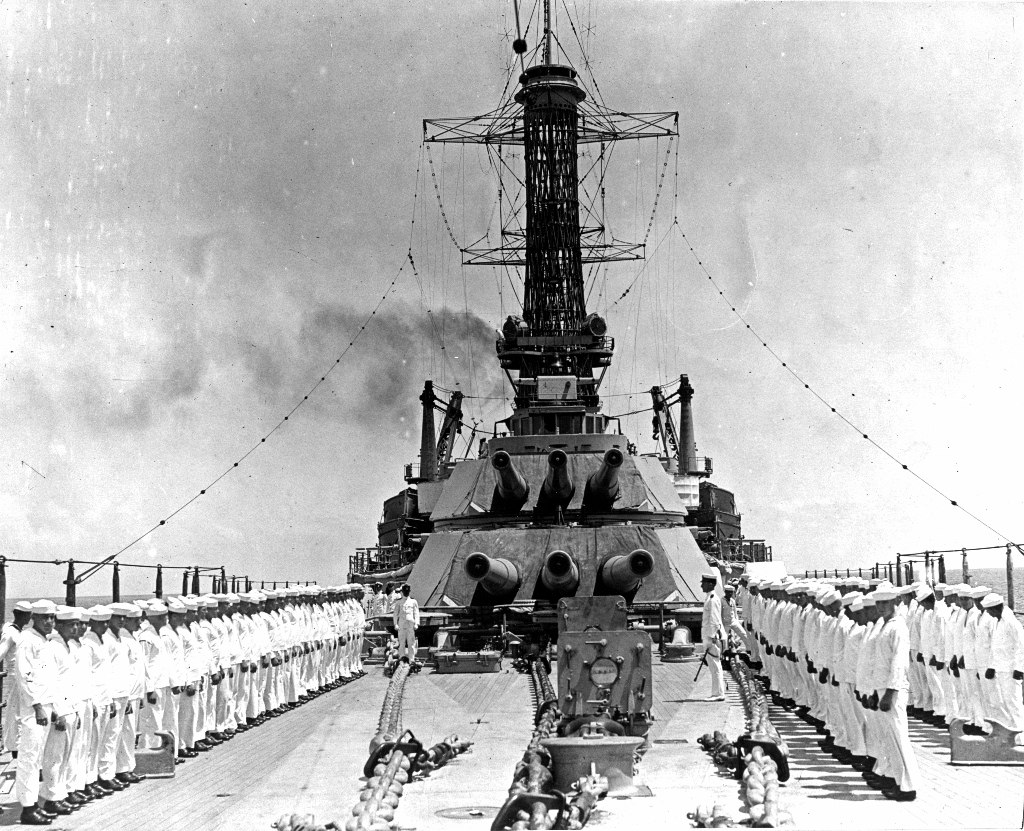
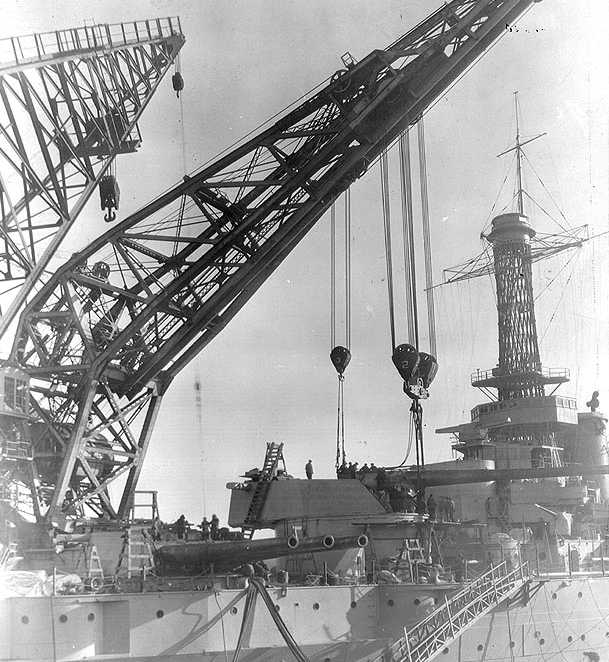
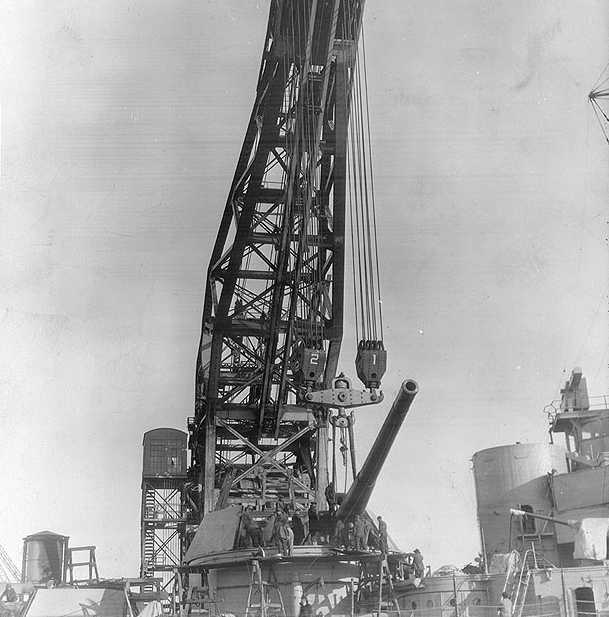

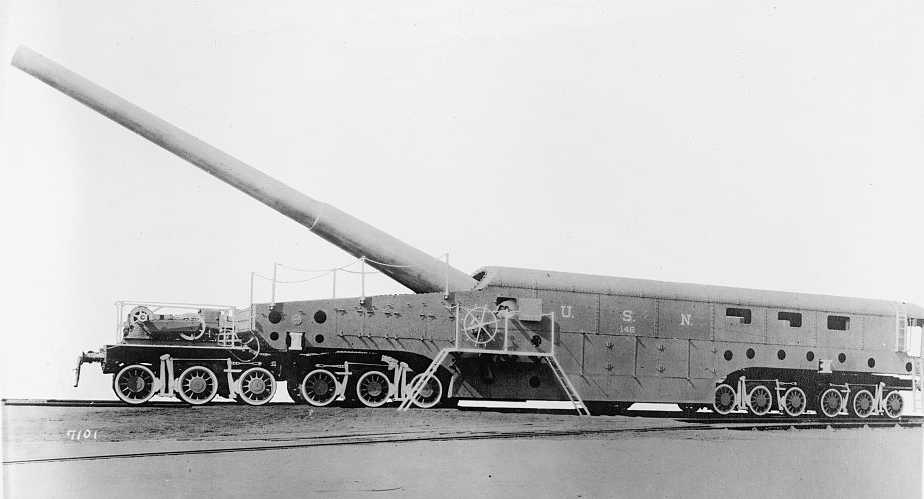
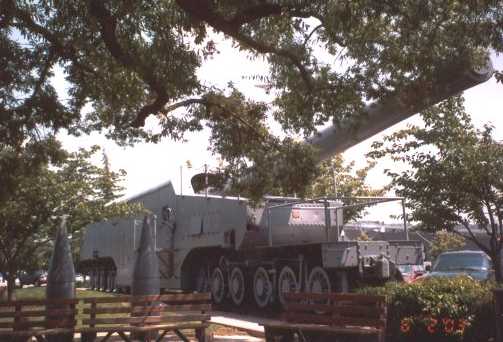

"Naval Weapons of World War Two" by John Campbell
"Naval Weapons of World War One", "US Naval Weapons" and "US Battleships: An Illustrated Design History" all by Norman Friedman
"The Big Gun: Battleship Main Armament 1860-1945" by Peter Hodges
"Battleships: United States Battleships, 1935-1992" by W.H. Garzke, Jr. and R.O. Dulin, Jr.
"The Evolution of Battleship Gunnery in the U.S. Navy, 1920-1945" article by William Jurens in Warship International No. 3, 1991
---
"Naval Ordnance - A Text Book" revised in 1915 by Lt. Cmdr. Roland I. Curtain and Lt. Cmdr. Thomas L. Johnson
"Navy Ordnance Activities: World War 1917-1918" by Bureau of Ordnance (BuOrd), Department of the Navy
"Gun Mount and Turret Catalog - Ordnance Pamphlet No. 1112" by Bureau of Ordnance (BuOrd), Department of the Navy, on the HNSA Website
"Abridged Range Tables for U.S. Naval Guns - Ordnance Pamphlet No. 1188 - 13 June 1944" by Bureau of Ordnance (BuOrd), Department of the Navy
"U.S. Explosive Ordnance - Ordnance Pamphlet No. 1664 - 28 May 1947" by Bureau of Ordnance (BuOrd), Department of the Navy
---
Special help from William Jurens, Steve Blake and Bolling Smith
15 August 2008 - Benchmark
09 January 2009 - Added information about Lexington Class
17 January 2009 - Added information about railway guns and created additional picture page
31 December 2009 - Added information on New Mexico class ammunition supply
04 February 2013 - Added cross-sectional sketch
22 April 2015 - Redid photograph of bow turrets on USS Idaho
11 July 2016 - Converted to HTML 5 format
24 April 2018 - Added photograph of USS Tennessee in drydock and reorganized notes
04 April 2020 - Added details on firing cycle and turret arrangements.
30 April 2022 - Added elevation and training speeds
28 June 2023 - Added comment about breech block opening angles
04 August 2023 - Revised range table
13 September 2023 - Added USS Mississippi accident
07 December 2023 - Minor text revision
28 July 2024 - Added information for the Tennessee class mountings
